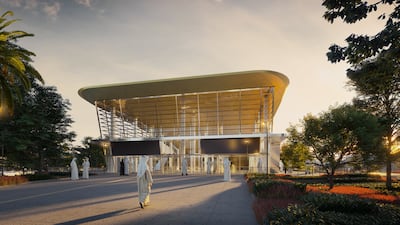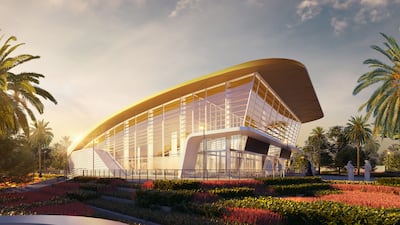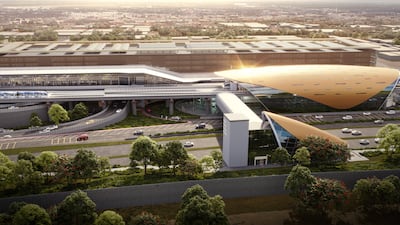Work on the latest addition to the Dubai Metro network has begun, with the upgrade expected to transform the north-east of the city, easing traffic congestion and establishing a direct link with Dubai International Airport.
On Monday, Sheikh Mohammed bin Rashid, Vice President and Ruler of Dubai, wrote on X that the foundation stone for the line’s first station has been laid, adding that it represents an “architectural icon”. Located in the Dubai Creek Harbour area, it will be called the Emaar Properties station and will be the highest metro station in the world at 74 metres.
The Dh18 billion ($4.9 billion) project will include 14 new stations and add 30km to the Metro network, with 15.5km underground.
The expansion is part of the Dubai 2040 Urban Master Plan launched in January last year, which included easier commuting among its top priorities to cater for a fast-growing population.
Dubai's Roads and Transport Authority said the Blue Line would connect five principal urban regions of Dubai – Bur Dubai/Deira, Downtown/Business Bay, Dubai Silicon Oasis, Dubai Marina/JBR and Expo City Dubai.
When completed, the Metro network will be 131km long and encompass 78 stations served by 168 trains.
Here, The National takes a look at what has been announced.
Where will Dubai Metro Blue Line go?
The new line will comprise two main routes that start with connections from the Red and Green Lines.
The first route is to begin in Al Jaddaf at the Creek Interchange Station on the Green Line and will cross Dubai Creek on a 1.3km bridge.
The route will pass through new stations at Dubai Festival City, Dubai Creek Harbour and Ras Al Khor, before reaching Dubai International City 1, which is an interchange station.
The line continues towards Dubai International City 2 and 3 and on to Dubai Silicon Oasis, with the route ending at Academic City. This part of the line section is to span 21km and features 10 stations.
The second route connects with the Red Line in Al Rashidiya at the Centrepoint interchange station.
It will connect with new stations at Mirdif and Al Warqaa, before connecting with the interchange station at Dubai International City 1. The new line on this section is to be 9km and will include four stations.
The travel time between these destinations is anticipated to be from 10 to 25 minutes.
The project also includes the construction of a metro depot at Al Ruwayyah 3, beyond Academic City.
When will it be completed?
The project is scheduled to be finished in 2029, coinciding with the 20th anniversary of the Dubai Metro.
Tenders for the project have already been launched, with the awarding of the contracts to contractors expected to take place next year.
Tunnelling for the underground sections of the routes and stations will start in 2025. The first trials are expected to take place in 2028.
Will the stations be any different?
The design of the stations will be largely in keeping with the current Metro routes, but the Blue Line will feature two noteworthy stations.
The RTA said Dubai Creek Harbour would have an "iconic station" with a "distinctive architectural design" that will complement the surrounding modern residential and commercial towers.
The station will be designed by global architectural firm Skidmore, Owings and Merrill, which designed Burj Khalifa, the Denver Union Station in Colorado and the Willis Tower in Chicago.
The other notable Metro station will be the underground site at International City, which will be 44,000 square metres – the largest underground interchange station in the network.
It has been designed to accommodate about 350,000 passengers a day.
What are the long-term benefits?
While the project will cost Dh18 billion, the RTA said the it would have economic, social and environmental benefits for the city.
By 2040, the project is projected to yield a benefit-cost ratio of 2.60 (Dh2.60 in benefits for every Dh1 spent), with total anticipated benefits exceeding Dh56.5 billion by 2040.
The project will help to reduce traffic congestion on its routes by 20 per cent and increase the value of land and properties near stations by up to 25 per cent, the RTA said.
It estimated that the Blue Line will serve 200,000 passengers a day by 2030, increasing to 320,000 a decade later. When it opens, 50,000 university students from Academic City are expected to make use of the line.
It is designed to handle an estimated capacity of about 56,000 passengers an hour in both directions, at a service interval of about 1.5 minutes.
Tamkeen's offering
- Option 1: 70% in year 1, 50% in year 2, 30% in year 3
- Option 2: 50% across three years
- Option 3: 30% across five years
Mercer, the investment consulting arm of US services company Marsh & McLennan, expects its wealth division to at least double its assets under management (AUM) in the Middle East as wealth in the region continues to grow despite economic headwinds, a company official said.
Mercer Wealth, which globally has $160 billion in AUM, plans to boost its AUM in the region to $2-$3bn in the next 2-3 years from the present $1bn, said Yasir AbuShaban, a Dubai-based principal with Mercer Wealth.
“Within the next two to three years, we are looking at reaching $2 to $3 billion as a conservative estimate and we do see an opportunity to do so,” said Mr AbuShaban.
Mercer does not directly make investments, but allocates clients’ money they have discretion to, to professional asset managers. They also provide advice to clients.
“We have buying power. We can negotiate on their (client’s) behalf with asset managers to provide them lower fees than they otherwise would have to get on their own,” he added.
Mercer Wealth’s clients include sovereign wealth funds, family offices, and insurance companies among others.
From its office in Dubai, Mercer also looks after Africa, India and Turkey, where they also see opportunity for growth.
Wealth creation in Middle East and Africa (MEA) grew 8.5 per cent to $8.1 trillion last year from $7.5tn in 2015, higher than last year’s global average of 6 per cent and the second-highest growth in a region after Asia-Pacific which grew 9.9 per cent, according to consultancy Boston Consulting Group (BCG). In the region, where wealth grew just 1.9 per cent in 2015 compared with 2014, a pickup in oil prices has helped in wealth generation.
BCG is forecasting MEA wealth will rise to $12tn by 2021, growing at an annual average of 8 per cent.
Drivers of wealth generation in the region will be split evenly between new wealth creation and growth of performance of existing assets, according to BCG.
Another general trend in the region is clients’ looking for a comprehensive approach to investing, according to Mr AbuShaban.
“Institutional investors or some of the families are seeing a slowdown in the available capital they have to invest and in that sense they are looking at optimizing the way they manage their portfolios and making sure they are not investing haphazardly and different parts of their investment are working together,” said Mr AbuShaban.
Some clients also have a higher appetite for risk, given the low interest-rate environment that does not provide enough yield for some institutional investors. These clients are keen to invest in illiquid assets, such as private equity and infrastructure.
“What we have seen is a desire for higher returns in what has been a low-return environment specifically in various fixed income or bonds,” he said.
“In this environment, we have seen a de facto increase in the risk that clients are taking in things like illiquid investments, private equity investments, infrastructure and private debt, those kind of investments were higher illiquidity results in incrementally higher returns.”
The Abu Dhabi Investment Authority, one of the largest sovereign wealth funds, said in its 2016 report that has gradually increased its exposure in direct private equity and private credit transactions, mainly in Asian markets and especially in China and India. The authority’s private equity department focused on structured equities owing to “their defensive characteristics.”
Zayed Sustainability Prize
Living in...
This article is part of a guide on where to live in the UAE. Our reporters will profile some of the country’s most desirable districts, provide an estimate of rental prices and introduce you to some of the residents who call each area home.
Milestones on the road to union
1970
October 26: Bahrain withdraws from a proposal to create a federation of nine with the seven Trucial States and Qatar.
December: Ahmed Al Suwaidi visits New York to discuss potential UN membership.
1971
March 1: Alex Douglas Hume, Conservative foreign secretary confirms that Britain will leave the Gulf and “strongly supports” the creation of a Union of Arab Emirates.
July 12: Historic meeting at which Sheikh Zayed and Sheikh Rashid make a binding agreement to create what will become the UAE.
July 18: It is announced that the UAE will be formed from six emirates, with a proposed constitution signed. RAK is not yet part of the agreement.
August 6: The fifth anniversary of Sheikh Zayed becoming Ruler of Abu Dhabi, with official celebrations deferred until later in the year.
August 15: Bahrain becomes independent.
September 3: Qatar becomes independent.
November 23-25: Meeting with Sheikh Zayed and Sheikh Rashid and senior British officials to fix December 2 as date of creation of the UAE.
November 29: At 5.30pm Iranian forces seize the Greater and Lesser Tunbs by force.
November 30: Despite a power sharing agreement, Tehran takes full control of Abu Musa.
November 31: UK officials visit all six participating Emirates to formally end the Trucial States treaties
December 2: 11am, Dubai. New Supreme Council formally elects Sheikh Zayed as President. Treaty of Friendship signed with the UK. 11.30am. Flag raising ceremony at Union House and Al Manhal Palace in Abu Dhabi witnessed by Sheikh Khalifa, then Crown Prince of Abu Dhabi.
December 6: Arab League formally admits the UAE. The first British Ambassador presents his credentials to Sheikh Zayed.
December 9: UAE joins the United Nations.
What the law says
Micro-retirement is not a recognised concept or employment status under Federal Decree Law No. 33 of 2021 on the Regulation of Labour Relations (as amended) (UAE Labour Law). As such, it reflects a voluntary work-life balance practice, rather than a recognised legal employment category, according to Dilini Loku, senior associate for law firm Gateley Middle East.
“Some companies may offer formal sabbatical policies or career break programmes; however, beyond such arrangements, there is no automatic right or statutory entitlement to extended breaks,” she explains.
“Any leave taken beyond statutory entitlements, such as annual leave, is typically regarded as unpaid leave in accordance with Article 33 of the UAE Labour Law. While employees may legally take unpaid leave, such requests are subject to the employer’s discretion and require approval.”
If an employee resigns to pursue micro-retirement, the employment contract is terminated, and the employer is under no legal obligation to rehire the employee in the future unless specific contractual agreements are in place (such as return-to-work arrangements), which are generally uncommon, Ms Loku adds.
Heavily-sugared soft drinks slip through the tax net
Some popular drinks with high levels of sugar and caffeine have slipped through the fizz drink tax loophole, as they are not carbonated or classed as an energy drink.
Arizona Iced Tea with lemon is one of those beverages, with one 240 millilitre serving offering up 23 grams of sugar - about six teaspoons.
A 680ml can of Arizona Iced Tea costs just Dh6.
Most sports drinks sold in supermarkets were found to contain, on average, five teaspoons of sugar in a 500ml bottle.
GREATEST ROYAL RUMBLE CARD
The line-up as it stands for the Greatest Royal Rumble in Saudi Arabia on April 27
50-man Royal Rumble
Universal Championship
Brock Lesnar (champion) v Roman Reigns
Casket match
The Undertaker v Rusev
Intercontinental Championship
Seth Rollins (champion) v The Miz v Finn Balor v Samoa Joe
SmackDown Tag Team Championship
The Bludgeon Brothers v The Usos
Raw Tag Team Championship
Sheamus and Cesaro v Bray Wyatt and Matt Hardy
United States Championship
Jeff Hardy (champion) v Jinder Mahal
Singles match
Triple H v John Cena
To be confirmed
AJ Styles will defend his WWE World Heavyweight title and Cedric Alexander his Cruiserweight Championship, but matches have yet to be announced
Electric scooters: some rules to remember
- Riders must be 14-years-old or over
- Wear a protective helmet
- Park the electric scooter in designated parking lots (if any)
- Do not leave electric scooter in locations that obstruct traffic or pedestrians
- Solo riders only, no passengers allowed
- Do not drive outside designated lanes
The%20specs
%3Cp%3E%3Cstrong%3EEngine%3A%20%3C%2Fstrong%3E2.3-litre%204cyl%20turbo%0D%3Cbr%3E%3Cstrong%3EPower%3A%20%3C%2Fstrong%3E299hp%20at%205%2C500rpm%0D%3Cbr%3E%3Cstrong%3ETorque%3A%20%3C%2Fstrong%3E420Nm%20at%202%2C750rpm%0D%3Cbr%3E%3Cstrong%3ETransmission%3A%20%3C%2Fstrong%3E10-speed%20auto%0D%3Cbr%3E%3Cstrong%3EFuel%20consumption%3A%20%3C%2Fstrong%3E12.4L%2F100km%0D%3Cbr%3E%3Cstrong%3EOn%20sale%3A%20%3C%2Fstrong%3ENow%0D%3Cbr%3E%3Cstrong%3EPrice%3A%20%3C%2Fstrong%3EFrom%20Dh157%2C395%20(XLS)%3B%20Dh199%2C395%20(Limited)%3C%2Fp%3E%0A
THE BIO
Age: 30
Favourite book: The Power of Habit
Favourite quote: "The world is full of good people, if you cannot find one, be one"
Favourite exercise: The snatch
Favourite colour: Blue
The biog
Age: 59
From: Giza Governorate, Egypt
Family: A daughter, two sons and wife
Favourite tree: Ghaf
Runner up favourite tree: Frankincense
Favourite place on Sir Bani Yas Island: “I love all of Sir Bani Yas. Every spot of Sir Bani Yas, I love it.”
BMW M5 specs
Engine: 4.4-litre twin-turbo V-8 petrol enging with additional electric motor
Power: 727hp
Torque: 1,000Nm
Transmission: 8-speed auto
Fuel consumption: 10.6L/100km
On sale: Now
Price: From Dh650,000
UK-EU trade at a glance
EU fishing vessels guaranteed access to UK waters for 12 years
Co-operation on security initiatives and procurement of defence products
Youth experience scheme to work, study or volunteer in UK and EU countries
Smoother border management with use of e-gates
Cutting red tape on import and export of food
more from Janine di Giovanni
Graduated from the American University of Sharjah
She is the eldest of three brothers and two sisters
Has helped solve 15 cases of electric shocks
Enjoys travelling, reading and horse riding
BUNDESLIGA FIXTURES
Saturday
Borussia Dortmund v Eintracht Frankfurt (5.30pm kick-off UAE)
Bayer Leverkusen v Schalke (5.30pm)
Wolfsburg v Cologne (5.30pm)
Mainz v Arminia Bielefeld (5.30pm)
Augsburg v Hoffenheim (5.30pm)
RB Leipzig v Bayern Munich (8.30pm)
Borussia Monchengladbach v Freiburg (10.30pm)
Sunday
VfB Stuttgart v Werder Bremen (5.30pm)
Union Berlin v Hertha Berlin (8pm)
Springsteen: Deliver Me from Nowhere
Director: Scott Cooper
Starring: Jeremy Allen White, Odessa Young, Jeremy Strong
Rating: 4/5





